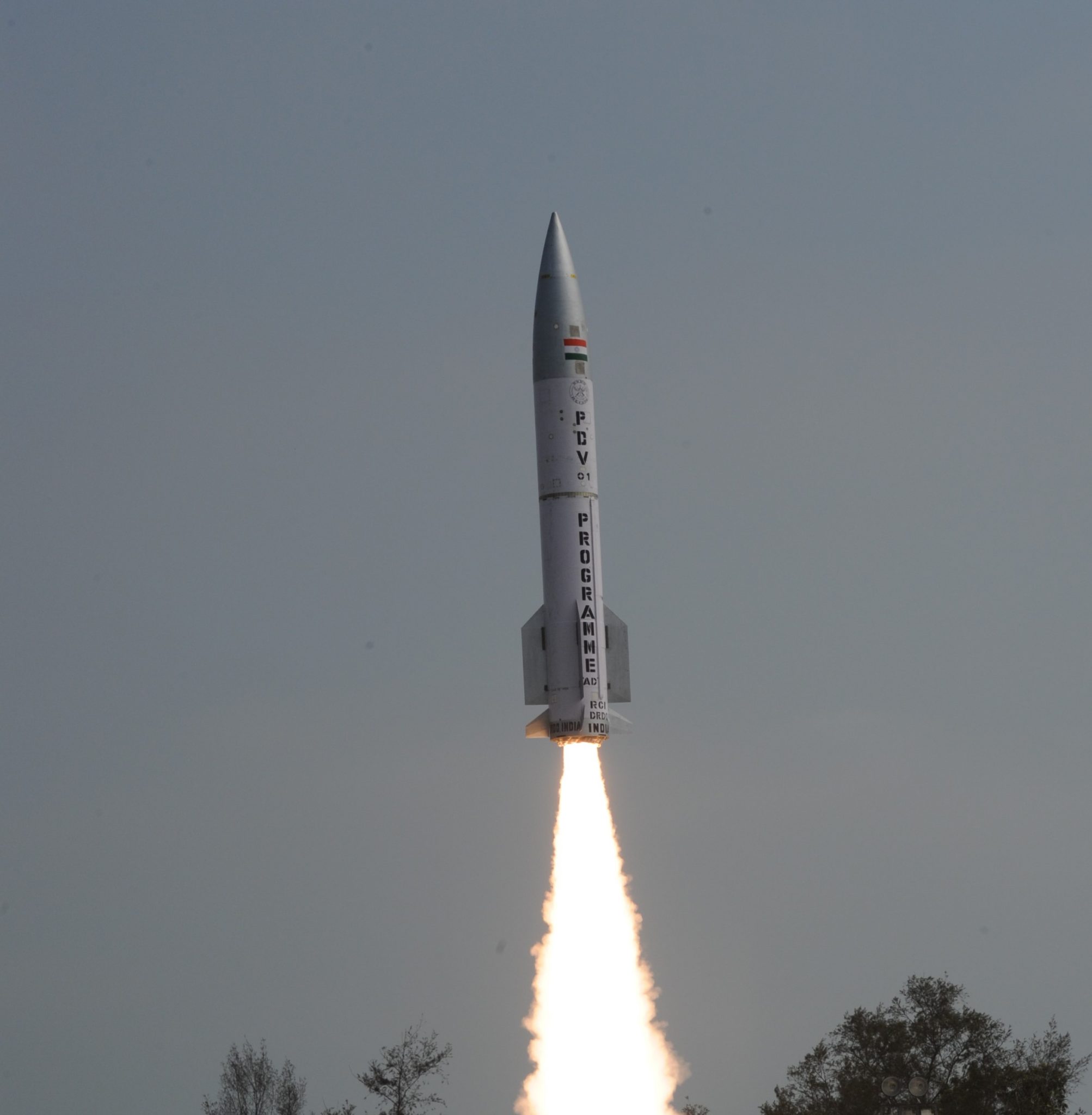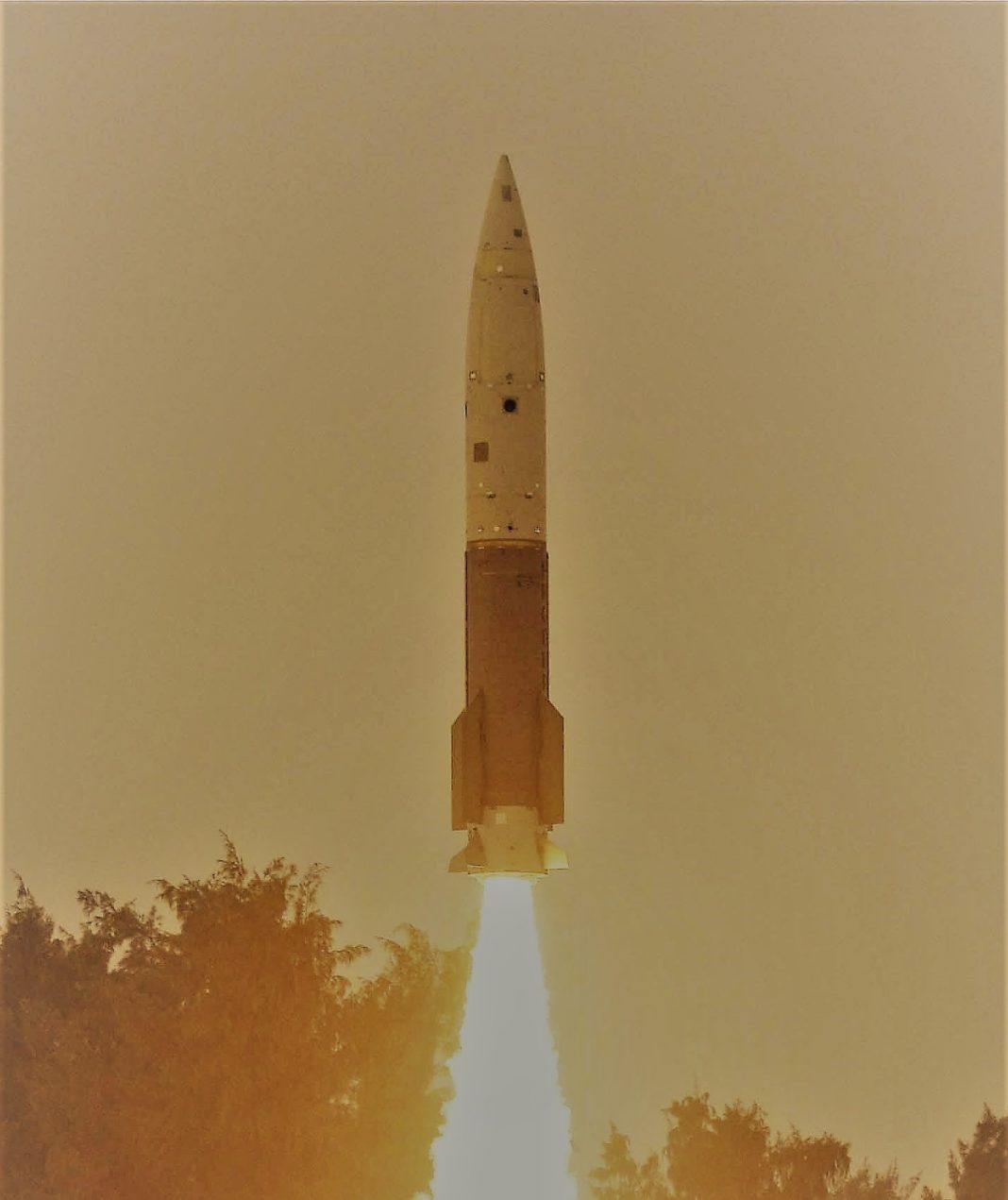The hit-to-kill (HTK) interception achieved by the Defence Research & Development Organization’s (DRDO’s) updated exo-atmospheric ‘PDV’ anti-ballistic missile (ABM) interceptor on February 11, 2017, was a watershed moment in the history of India’s ballistic missile defence (BMD) program. The exo-atmospheric intercept achieved at an altitude of 97 km validated among other things, the improved guidance algorithm used for this test-mission, since the incoming missile target had deviated significantly from what would have allowed an intercept along a typical minimum energy trajectory (MET) for an ABM interceptor. Instead, the PDV test-vehicle had to slam into the target at the far end of its engagement boundary and at a lower altitude than what a ‘standard’ MET intercept would have entailed.
An intercept of this nature may also be indicative of the maturity of the on-board imaging infrared seeker (IIR), the responsiveness of the divert and attitude control system (DACS) used by the PDV’s kinetic kill vehicle (KKV), as well as the sensor fusion achieved by various tracking systems involved in the mission.
A closer look at PDV
PDV serves as an exo-atmospheric interceptor for India’s emerging two-tier ballistic missile defence (BMD) system consisting of both endo and exo atmospheric interception capability. DRDO first tested PDV in 2014 (see the embedded video) in a mission that was essentially used to validate the ABM interceptor’s integration with the detection, tracking and automated launch control systems associated with the two-tier BMD scheme and no actual intercept was attempted that time over. This latest test however was used to prove the KKV used by PDV by destroying an actual incoming warhead in a HTK mission.
Now, PDV replaces the PAD ABM interceptor, which was first tested in 2006, as the kill vector in the high-altitude interception leg of the two-tier system conceived under Phase-I of India’s BMD programme. However, while PAD was essentially a high endo-atmospheric system with a ceiling of around 85 km, PDV is a true blue exo-atmospheric interceptor capable of destroying targets at altitudes of up to 150 km. This puts PDV in a different category in terms of its navigation set-up and homing seeker capability. Instead of sporting a radio frequency (RF) seeker like PAD, PDV uses a strap-down IIR seeker developed by DRDO’s Research Centre Imarat (RCI) with a 128 x 128 focal plane array.

An image from the first test in April 2014
Once the development of PDV is successfully complete, it would signal the maturing of Phase-1 of India’s BMD program which is designed to provide credible capability against theatre ballistic missiles (TBM) launched from up to 2000 km away.
Far above the clouds
Exo-atmospheric interception certainly has its advantages in terms of extending the amount of time available to a BMD system to direct interceptors towards an incoming target. On the other hand, an interception of a medium range ballistic missile (MRBM) re-entry vehicle (RV) outside the Earth’s atmosphere may require that the BMD system distinguish between it (i.e the RV) and decoys, that might be released by the boost vehicle in order to create false targets. This target discrimination is achieved in the ‘cold’ of space by using an IIR seeker. PDV’s inertial guidance package that includes a ring-laser gyroscope (RLG) moved its solid-fuelled booster towards the estimated point of interception as calculated by ground-based radars, till such time the KKV was released and its IIR seeker took over in the end game to track the RV. After which, the KKV steered itself continuously to plot a collision course with the incoming RV. In the end, the KKV managed to smash right into the central portion of the RV.
Incidentally, a new interceptor of the class of PDV also requires a new MRBM class target missile for effective trials. In this test DRDO used a two-stage target, comprising a new solid-fuelled second stage that sits atop a liquid fuelled Prithvi booster first stage. This target missile successfully mimics the 3-4 km/sec re-entry speeds of a ‘hostile’ ballistic missile approaching from more than 2000 km away. The target missile was fired from a naval platform sitting offshore.
Now, one of the things to check in a layered approach to BMD is the modularity of the systems involved which allows the use of different interceptors with the same command and control network (C2) leading to cost savings through logistical simplicity and interoperability. This PDV test in that sense validates the successful integration of the interceptor with DRDO’s proven ground based automated response network that forms the backbone of the two-tier BMD scheme.
C4ISR
Indeed, this test also serves to yet again validate DRDO’s overall BMD C4ISR architecture which consists of both over the horizon and X-band fire control radars which detect and track the incoming missile, a mission control centre (MCC) that fuses input (which may also come from satellite based sensors), processes it and then sends orders for engagement to launch control centres (LCCs) situated up to a 1000 km away via mobile communication terminals (MCTs). The LCCs then orchestrate the final launch sequence with the mobile interceptor sitting nearby. Repeated tests of the two-tier system, including the latest PDV test has given enough confidence to DRDO to recommend the freezing of the current configuration for Phase-I. Both the radars and the LCCs receive and send information via target update transmitters (TUTs) based on CDMA technology. While the MCTs of the MCC are themselves connected via an IP wide area network, data-links for the entire setup also include fibre optic communication channels and line of sight relays.
A bigger boost than usual
PDV, given its role as an exo-atmospheric interceptor is obviously larger and has more on-board fuel than the AAD endo-atmospheric interceptor. The PDV booster uses solid propellants which have high burn-rates and can function effectively in temperatures ranging from minus 40 degrees to 50 degrees celsius above zero. An operating paradigm such as this requires special casting for the propellants developed by DRDO’s High Energy Material Research laboratory (HEMRL). PDV is also designed to have a shelf life of 10 to 15 years and its motors have a high margin for safety while retaining quick reaction capability – all of which contribute to it being a ready to use package slaved to an automated launch mechanism. Moreover, PDV’s motors obviously have to be fairly robust to withstand the rigours and vibrations induced by mobility. The DACS on board PDV’s KKV is fuelled by hypergolic propellants, with high thruster valves which can precisely control the flow of propellant to the rocket engines used for KKV steering.
Left unsaid in this latest BMD test by DRDO is the clear demonstration of the low earth orbit (LEO) capabilities of PDV. PDV is actually a predecessor to another exo-atmospheric interceptor currently under development that can neutralize RVs at altitudes of over 300 km. Taken together this means that India has all the elements in place for a direct ascent counter space system that can potentially be used for anti-satellite purposes. This in turn means that India now has a very strong hand in the Space NPT that is currently being quietly negotiated by the world’s nuclear powers.
© Delhi Defence Review. Reproducing this content in full without permission is prohibited.
































